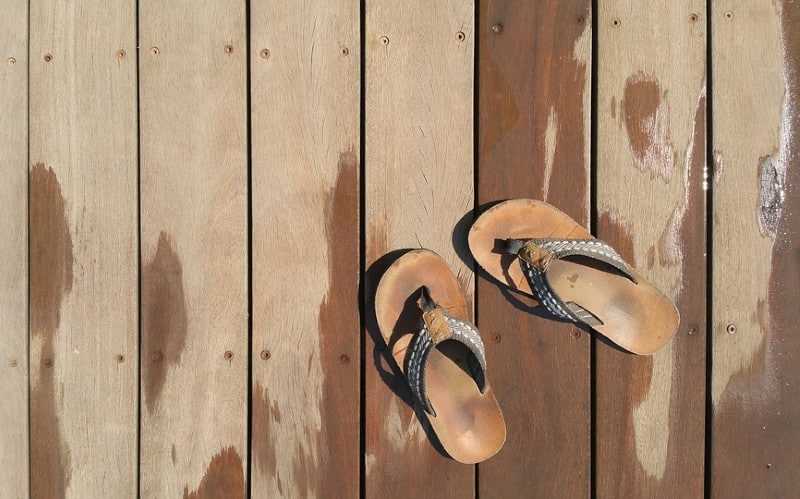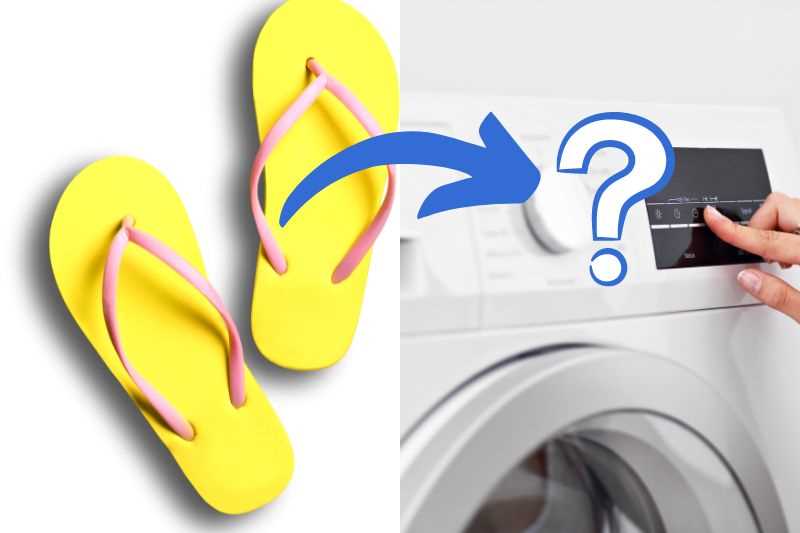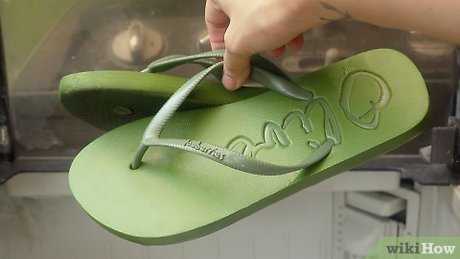


Flip flops are a popular and comfortable choice of footwear, especially during the summer months. However, after frequent use, flip flops can become dirty and smelly, making many people wonder if they can be cleaned in a washing machine. In this article, we will provide expert tips and advice on whether or not it is safe to put flip flops in the washing machine.
One of the key factors to consider when deciding whether or not to machine wash your flip flops is the material they are made from. While some flip flops are made from durable and water-resistant materials such as rubber or plastic, others may be made from more delicate materials like fabric or leather. The material will determine whether or not it is safe to wash your flip flops in a machine.
If your flip flops are made from rubber or plastic, it is generally safe to machine wash them. However, it is important to use a gentle cycle with cold water, and avoid using harsh detergents or bleach that could damage the material. It is also recommended to place the flip flops in a mesh laundry bag or pillowcase to protect them from getting caught or damaged during the wash.
On the other hand, if your flip flops are made from fabric or leather, it is not recommended to machine wash them. These materials can easily become misshapen or damaged in a washing machine, and it is best to clean them by hand using a mild detergent and a soft brush. If they have any stains, treating them with a stain remover before washing can help remove them effectively.
In conclusion, whether or not you can put flip flops in the washing machine depends on the material they are made from. Rubber or plastic flip flops can generally be machine washed, but it is important to use a gentle cycle with cold water and protect them in a mesh laundry bag. However, fabric or leather flip flops should be hand washed to avoid damage. By following these expert tips and advice, you can keep your flip flops clean and fresh throughout the summer season.
Expert Opinion on Washing Flip Flops
When it comes to washing flip flops, experts have varying opinions. Some recommend hand washing them, while others say it’s okay to throw them in the washing machine. However, there are several important factors to consider before deciding on the best method for cleaning your flip flops.
Material
The material of your flip flops plays a crucial role in determining how they should be cleaned. Flip flops made of rubber or similar waterproof materials can generally be safely washed in the machine. On the other hand, flip flops made of leather, fabric, or delicate materials may require more gentle cleaning methods.
Machine Washing
If you decide to wash your flip flops in the machine, there are a few key steps to follow. First, remove any loose dirt or debris from the flip flops. Next, place them in a pillowcase or mesh laundry bag to protect them during the wash cycle. Use a mild detergent and select a gentle cycle with cold water. Avoid using bleach or strong chemicals, as they can damage the flip flops. Finally, let them air dry completely before wearing them again.
Hand Washing
For flip flops made of delicate materials or those that are not suitable for machine washing, hand washing is the preferred method. Fill a basin or sink with warm water and a small amount of mild detergent. Gently scrub the flip flops with a soft brush or cloth, paying special attention to any stained or dirty areas. Rinse thoroughly with clean water and air dry them away from direct sunlight.
Frequent Cleaning
Regardless of the cleaning method you choose, it’s important to regularly clean your flip flops to maintain their appearance and prevent the buildup of dirt and bacteria. This is especially important if you wear your flip flops in humid or outdoor environments where they are exposed to sweat, dirt, and other elements.
Summary
- Consider the material of your flip flops before deciding on a cleaning method. Rubber flip flops can usually be machine washed, while delicate materials require gentle hand washing.
- If using a washing machine, protect the flip flops by placing them in a pillowcase or mesh laundry bag and using a gentle cycle with cold water.
- Avoid using bleach or strong chemicals that can damage the flip flops.
- Hand washing is the preferred method for delicate or unsuitable materials. Scrub gently with mild detergent and air dry away from direct sunlight.
- Regularly clean your flip flops to maintain their appearance and prevent the buildup of dirt and bacteria.
Best Practices for Cleaning Flip Flops in the Washing Machine
While it’s generally safe to clean most flip flops in the washing machine, there are still some best practices to follow to ensure the best results and to prolong the lifespan of your flip flops. Here are some expert tips to consider:
- Check the manufacturer’s instructions: Before washing your flip flops, always refer to the manufacturer’s guidelines for cleaning. Some flip flops may have specific instructions that need to be followed to avoid damage.
- Remove any excess dirt: Before placing your flip flops in the washing machine, make sure to remove any visible dirt or debris. This can be done by brushing or wiping them with a soft cloth or brush.
- Secure the flip flops: To ensure that your flip flops don’t get tangled or damaged during the washing cycle, it’s a good idea to secure them in a mesh laundry bag or pillowcase. This will help protect the delicate straps and prevent any damage.
- Use a gentle cycle and mild detergent: When washing your flip flops, opt for a gentle cycle on your washing machine with cold or lukewarm water. Additionally, use a mild detergent that is suitable for delicate items. Avoid using bleach or harsh chemicals, as they can cause discoloration or damage.
- Avoid heat: It’s important not to expose your flip flops to high heat. Avoid using a dryer or placing them near direct sunlight to prevent warping or melting.
- Air dry: After washing, remove the flip flops from the washing machine and let them air dry naturally. Placing them in direct sunlight or using a heater can cause the materials to dry out and become brittle.
- Inspect for damage: Once your flip flops are dry, take the time to inspect them for any signs of damage. Look for loose threads, loose soles, or any other issues that may need to be addressed. If necessary, consider getting them repaired or replaced.
Following these best practices will help ensure that your flip flops come out of the washing machine clean and undamaged. Remember to always check the manufacturer’s instructions before cleaning and take proper care of your flip flops to extend their lifespan.
Precautions and Risks of Washing Flip Flops in the Machine
While it may be tempting to throw your dirty flip flops into the washing machine for a quick and easy clean, there are some precautions and risks that you should be aware of. It’s important to consider these factors before deciding to machine wash your flip flops.
1. Material and Construction
Flip flops are typically made from a variety of materials such as rubber, foam, or synthetic straps. These materials may not be designed to withstand the harsh conditions inside a washing machine. The agitation and spinning motion of the machine can cause damage to the flip flops, resulting in tears, stretched straps, or misshapen soles.
2. Sole Integrity

The soles of flip flops often have specialized features or tread patterns that provide traction and comfort. Machine washing can wear down these features, reducing the effectiveness of the flip flops and compromising their overall quality. It’s important to consider whether the potential loss of sole integrity is worth the convenience of machine washing.
3. Odor and Bacteria
Flip flops can accumulate dirt, oils, and bacteria over time, which can lead to unpleasant odors. While machine washing can help to remove some of these contaminants, it may not completely eliminate them. Additionally, the warm and damp environment inside the washing machine can create an ideal breeding ground for bacteria. This can cause the flip flops to retain a damp and musty smell even after washing.
4. Noise and Damage to the Machine
The irregular shape and lightweight nature of flip flops can cause them to bounce around and create excessive noise during the washing cycle. This can be disruptive and potentially damage the machine or other items being washed. It’s important to consider the impact on your machine and the environment in which it is being used.
5. Alternative Cleaning Methods
Instead of machine washing, consider alternative cleaning methods that may be more suitable for flip flops. Hand washing with mild soap and water, or using a soft-bristle brush to clean the straps and soles, can be effective in maintaining the cleanliness of your flip flops while reducing the risk of damage. It’s important to follow the manufacturer’s care instructions and recommendations for cleaning.
In conclusion, while it may be tempting to machine wash your dirty flip flops, there are several precautions and risks to consider. Taking the time to assess the material and construction of your flip flops, the potential impact on sole integrity, the risk of odor and bacteria, the potential for noise and damage to the machine, and the availability of alternative cleaning methods will help you make an informed decision about the best way to clean your flip flops.
Alternative Methods for Cleaning Flip Flops
If you don’t have a washing machine or prefer not to put your flip flops in the machine, there are alternative methods for cleaning them. Here are a few options:
Hand Washing
One of the simplest ways to clean flip flops is to wash them by hand. Fill a basin or sink with warm water and add a small amount of gentle detergent, such as dish soap or laundry detergent. Use a soft brush or cloth to scrub the flip flops, paying extra attention to any dirty or stained areas. Rinse thoroughly with clean water and towel dry.
Vinegar Soaking

Vinegar can be used to remove odors and kill bacteria on flip flops. Mix equal parts water and white vinegar in a basin or sink and let the flip flops soak for about 30 minutes. After soaking, scrub with a soft brush or cloth to remove any remaining dirt or stains. Rinse well with clean water and air dry.
Baking Soda Paste

Baking soda is a natural cleaning agent that can help remove stains and odors from flip flops. Make a paste by mixing baking soda with a small amount of water. Apply the paste to the dirty areas of the flip flops and scrub with a soft brush or cloth. Rinse thoroughly with clean water and allow to dry.
Hydrogen Peroxide Solution

Hydrogen peroxide can be effective in removing tough stains from flip flops. Mix equal parts hydrogen peroxide and water in a basin or sink. Soak the flip flops in the solution for about 20 minutes, then scrub with a soft brush or cloth. Rinse well with clean water and air dry.
Using a Toothbrush
If your flip flops have intricate patterns or hard-to-reach areas that are difficult to clean, using a toothbrush can help. Dip a toothbrush in warm, soapy water and scrub the dirty areas of the flip flops. Rinse well with clean water and towel dry.
Preventative Care
To keep your flip flops clean and in good condition, it’s important to practice preventative care. Here are a few tips:
- After wearing your flip flops, wipe them down with a damp cloth to remove any dirt or debris.
- Avoid wearing flip flops in muddy or dirty areas.
- Store your flip flops in a dry, ventilated area to prevent mold and mildew.
- Consider using a protective spray or coating to help repel dirt and water.
By following these alternative cleaning methods and practicing preventative care, you can keep your flip flops looking and smelling fresh for longer.
Tips to Extend the Lifespan of Flip Flops
1. Choose a high-quality pair

Investing in a high-quality pair of flip flops can go a long way in extending their lifespan. Look for flip flops made from durable materials, such as rubber or leather, that are known for their longevity. Cheaper, low-quality flip flops may wear out quickly and need to be replaced frequently.
2. Protect them from excessive heat
Flip flops can be sensitive to heat and direct sunlight, which can cause the materials to warp or crack. Avoid leaving your flip flops in hot cars or direct sunlight for extended periods of time. Store them in a cool, dry place when not in use to help preserve their shape.
3. Clean them regularly
Regularly cleaning your flip flops can help maintain their appearance and prevent the buildup of dirt and grime. Use a mild soap and warm water to gently scrub the surface of your flip flops. Avoid using harsh chemicals or abrasive scrub brushes, as these can damage the materials.
4. Avoid walking on rough surfaces
Walking on rough surfaces, such as gravel or concrete, can cause excessive wear and tear on flip flops. Try to avoid wearing your flip flops in these conditions, or opt for a sturdier pair of shoes when walking on rough terrain.
5. Rotate your flip flops
Rotating between multiple pairs of flip flops can help extend their lifespan. By allowing each pair to rest and recover between wears, you can reduce the likelihood of excessive wear and tear. It’s also a good idea to alternate between different styles of flip flops to give each pair a break.
6. Store them properly
When not in use, store your flip flops in a clean and dry area to prevent them from accumulating dust or moisture. Consider using a shoe rack or container specifically designed for flip flops to help maintain their shape and keep them organized.
7. Replace worn-out soles
If the soles of your flip flops become worn out or start to lose their grip, consider replacing them. Many flip flop manufacturers offer replacement soles or repair services, which can help extend the lifespan of your favorite pair.
8. Avoid excessive water exposure

While flip flops are often worn around water, excessive exposure to water can damage the materials and shorten their lifespan. Avoid wearing flip flops in situations where they may become fully submerged in water for extended periods of time.
9. Don’t overuse them
Using your flip flops for activities they aren’t designed for, such as intense sports or long walks, can cause them to wear out quickly. Stick to using your flip flops for casual activities and opt for sturdier footwear when more support is needed.
10. Repair minor damages promptly

If you notice any minor damages, such as loose straps or loose threads, it’s best to repair them promptly. Ignoring these small issues can lead to larger problems and decrease the lifespan of your flip flops. Use a strong adhesive or thread to mend any minor damages before they worsen.
FAQ
Can I clean my flip flops in the washing machine?
Yes, you can clean your flip flops in the washing machine. However, there are some things you need to consider to prevent damage to your flip flops.
What should I do before putting my flip flops in the washing machine?
Before putting your flip flops in the washing machine, you should remove any loose dirt or debris by rinsing them with water. This will help prevent the dirt from clogging the washing machine or damaging your flip flops during the wash cycle.
Can I wash flip flops with other clothes?
It is generally recommended to wash flip flops separately from other clothes. This is because the straps or soles of the flip flops can get tangled with other items and cause damage. It’s best to put them in a mesh laundry bag or pillowcase to keep them contained during the wash.
Should I use hot or cold water when washing my flip flops?
It is recommended to use cold water when washing your flip flops. Hot water can cause the materials to shrink or warp, especially if your flip flops are made of plastic or rubber.
Can I put my flip flops in the dryer after washing?
Avoid putting your flip flops in the dryer after washing them. The high heat can cause the materials to warp or melt. Instead, let them air dry in a well-ventilated area, away from direct sunlight.











